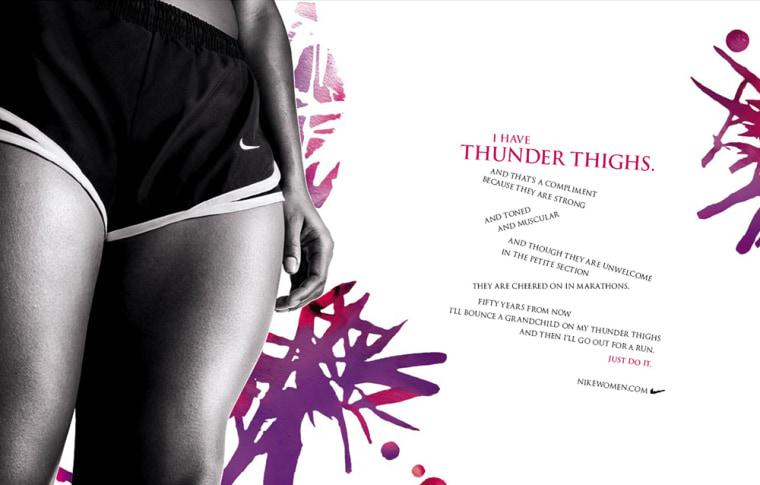It’s no longer just rail-thin models who are showing up in fashion magazines and on billboards. Large women, or what are being called "real people," are now gracing ads of companies selling everything from tuna to cellulite cream.
Nike Inc., the world’s largest maker of athletic shoes, has jumped onto the bandwagon with a campaign featuring close-ups of “big butts” and “thunder thighs.”
Look closely at the text, however, and you discover that the body parts featured in the pictures belong to women who spend a lot of time working out.
“It looks like a volleyball player. Like a very athletic woman — not someone fat,” said Britt Hansen, 20, poring over the “thunder thighs” spread inside the locker room of a local gym in downtown Portland.
“It ain’t that big,” agreed Douglas Burzell, a computer tech who glanced at the “My butt is big” ad while sipping his Starbucks coffee about 10 miles from Nike’s Beaverton, Ore. headquarters.
The new Nike campaign, said company spokeswoman Caren Bell, is attempting to portray “what is real” as opposed to “the ideal.”
When a woman works out, her body develops, becoming more muscular, instead of model-thin. And that’s a look the ads are trying to celebrate, she said.
It fits right in with a reality trend in the beauty industry overall, said Cindi Leive, editor-in-chief of Glamour magazine, which is prominently featuring the “big butt” ad in its September issue.
“If you’re born a size 12, you will not become a size 0 and any product that tells you (that) you have to do that to be happy will not get your attention anymore,” she said.
A recent survey of 1,000 American women by Allure magazine supports that conclusion, said the magazine’s publisher, Nancy Berger Cardone. Editors at the magazine were astonished, she said, when 91 percent of the respondents said they were satisfied with what they see in the mirror.
For that reason, it makes sense for advertisers to pitch products to women who hope to improve their looks in a realistic manner, rather than those indulging in a faraway fantasy.
“Women are wanting to be themselves — but better,” she said.
Nike’s campaign comes on the heels of ads for cellulite cream by Unilever N.V.’s Dove showing unretouched, “real” women of varying sizes in bras, panties and a broad smile. “As tested on real curves,” reads the text underneath the photograph.
In the food industry, Chicken of the Sea just launched a TV campaign featuring a beautiful woman, who runs into an elevator and allows herself to exhale, exposing her large tummy.
The people in Nike’s new campaign are toned women, whose curves are the results of swimming, dancing, playing soccer and running.
“My butt is big and round like the letter C,” states the text that goes with a picture showing a woman’s tight derriere. “And ten thousand lunges have made it rounder. But not smaller. And that’s just fine.”
Showing an image of a woman in shorts from the waist down, another ad proclaims: “I have thunder thighs. And that’s a compliment because they are strong and toned and muscular.”
'Marathon legs'
Asked to look at the ads without the words, randomly chosen people in downtown Portland described the women as fit. When they saw the accompanying description, several were surprised.
“Thunder thighs? No, she’s not fat. Those are marathon legs. That’s a healthy woman who’s active and in shape and cares about her body,” said Kim Lynn, 33, a Pilates and Spinning instructor at a local gym.
Lynn concluded the ad had a positive message: “It’s as if they’re taking a derogatory statement — and making it not be that.”
The ad is at odds with itself by using terms like “thunder thighs” next to fit women, says Barbara Lippert, the New York-based ad critic for Adweek, a trade magazine that chronicles the advertising industry.
But she said the ad is truthful to Nike’s core audience — the athletic woman, who is not a waif, but not obese, either.
She said depicting a truly obese subject is not likely to please anyone: “If they were actually cellulitic and gross no one would want to see it.”
The anti Barbie doll movement has a long history in advertising, said Liz Schroeder, executive director of Advertising Women of New York, an industry association.
In the 1990s, the Body Shop built a campaign around a voluptuous doll named Ruby, the company’s “self-esteem mascot.” On one set of images, the tagline below her ample figure read: “There are 3 billion women who don’t look like supermodels and only 8 who do.”
What is new, Schroeder said, is the fact that big companies like Nike are using the same marketing strategy.
“The average woman is not 5’2, blond with blue eyes and straight white teeth, and somebody somewhere along the line has realized that women want to see products that they can relate to,” she said. “And when a company like Nike does it, it really gets attention.”
